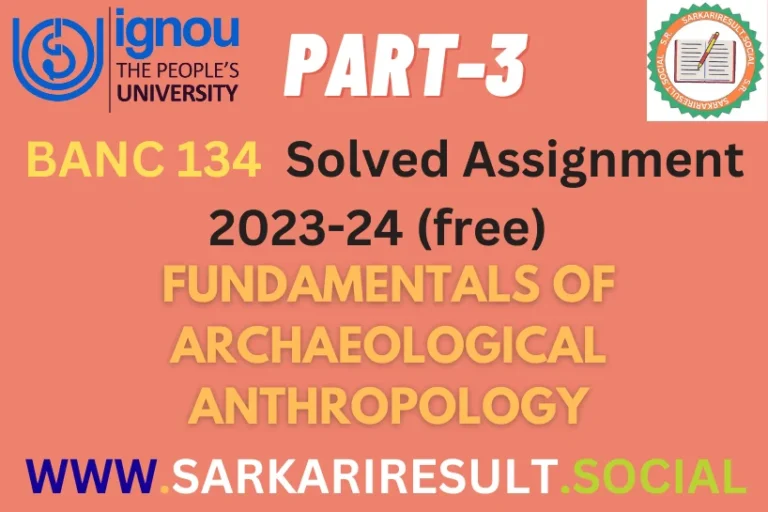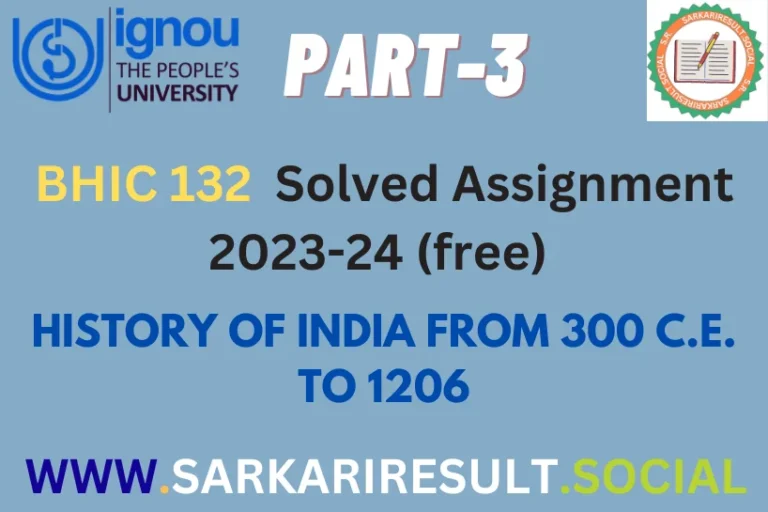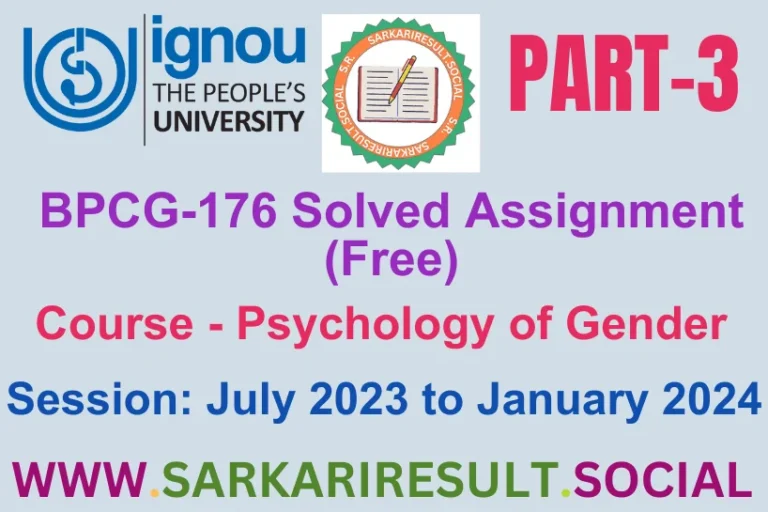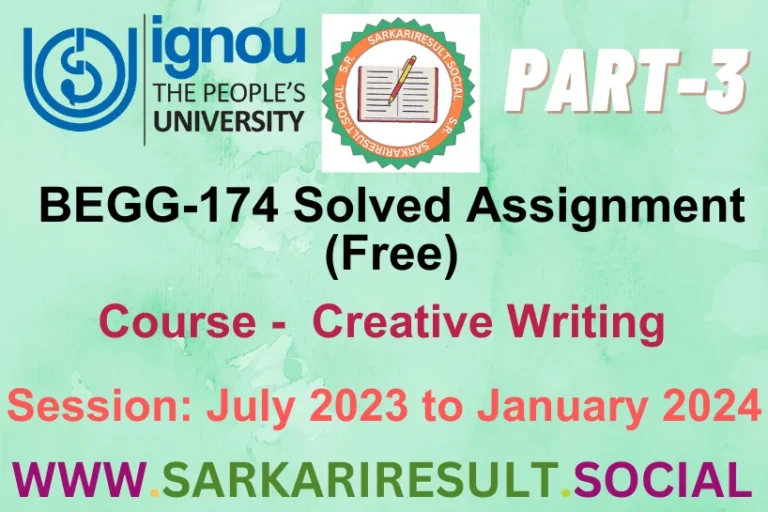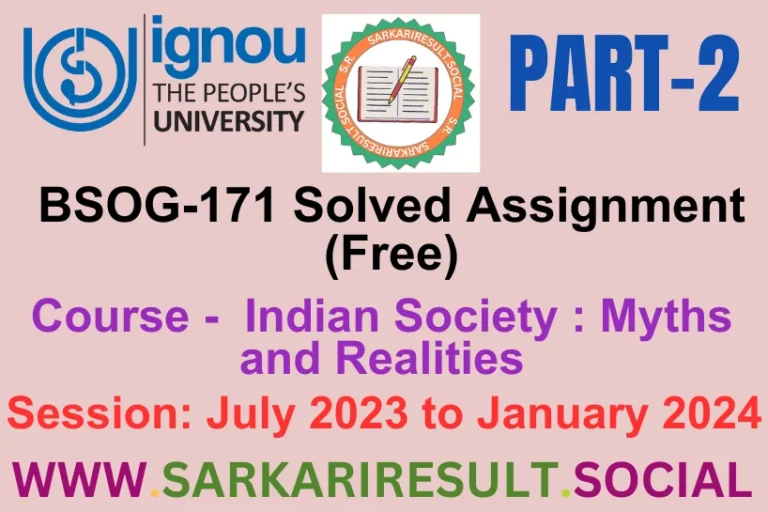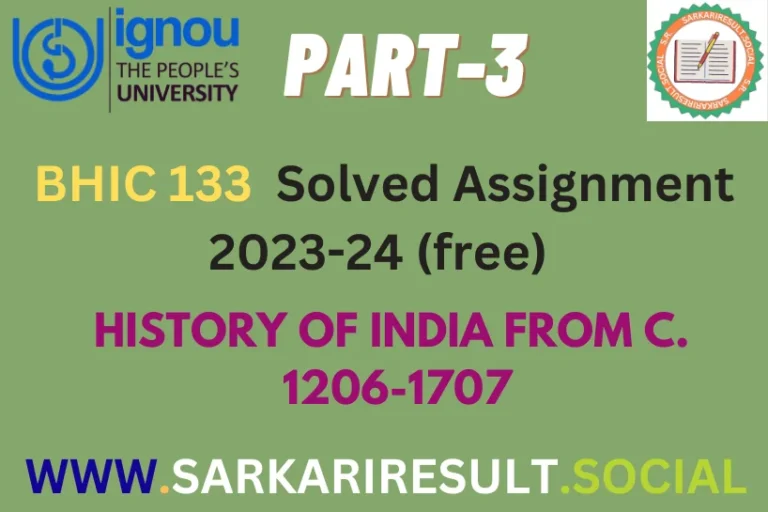Check top Begae 182 IGNOU solved assignment 2023-24 (Free)
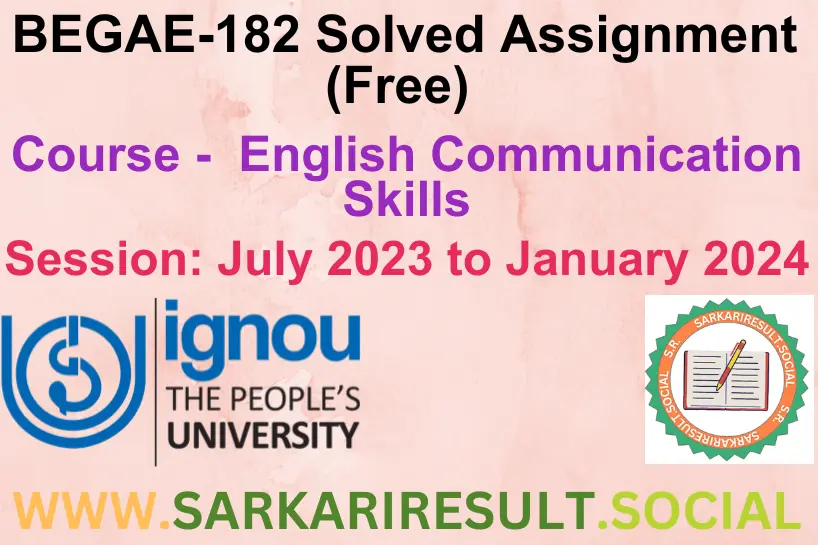
Begae 182 IGNOU solved assignment 2023-24
“Looking for BEGAE 182 IGNOU solved assignment 2023-24 (Free) ? Master your English Communication Skills with our comprehensive and expertly crafted solved assignment. Score high marks in the Tutor Marked Assignment (TMA) carrying 100 marks. Our meticulously prepared solution ensures a critical analysis of the course material, enhancing your application skills. Follow the provided instructions to present a well-structured and concise response. Submit your neatly handwritten assignment before the Term End Examination to meet the submission deadline. Don’t miss this opportunity to excel! Get your IGNOU BEGAE-182 solved assignment now!”
Begae 182 Solved (Questions and Answers)

Q.1 What do you understand by the term ‘non-verbal communication’? What are its advantages?
Ans. Non-verbal communication is a way of expressing and understanding messages without using words. It involves using facial expressions, gestures, body movements, tone of voice, and even eye contact to convey thoughts and feelings. Imagine you’re watching a silent movie – the actors use their expressions and actions to tell a story without saying anything. Similarly, non-verbal communication adds meaning and depth to our conversations and interactions.
Advantages of non-verbal communication are like secret tools that help us connect with others and understand them better. Firstly, it helps us express emotions. When you smile, people know you’re happy; when you frown, they can tell you’re not pleased. These expressions let others know how you feel, even if you don’t say a word. Secondly, non-verbal cues enhance spoken words. Imagine saying “thank you” with a big smile – it makes your gratitude even more heartfelt. Thirdly, it helps us understand others. When someone crosses their arms, you might sense they’re feeling defensive or closed off. These signals guide us in figuring out what people really mean, beyond their words.
Moreover, non-verbal communication is like a language of its own. When you give a thumbs up, it means “good job!” without having to say it. This saves time and makes communication faster. Lastly, it can help build strong relationships. Good eye contact and friendly gestures show you’re interested and respectful, which helps people trust and like you.
In conclusion, non-verbal communication is a powerful way of expressing ourselves and understanding others. It adds meaning, emotion, and clarity to our conversations, making our interactions more genuine and enjoyable.
Q.2 Write a short note on Macro functions of communication.
Ans. The macro functions of communication are like the main reasons why we talk to each other. They help us achieve different goals when we communicate with others. Imagine communication as a toolbox, and these functions are like the tools we use to build better understanding and connections.
1. **Informative Function**: This is when we use communication to share information, facts, or ideas with others. It’s like giving someone directions or explaining how something works. For example, when a teacher teaches a lesson or you tell your friend about a cool fact, you’re using the informative function.
2. **Expressive Function**: Imagine communication as a way to show our feelings and thoughts. This function lets us share emotions and opinions. When you tell your family you’re excited about a trip or that you’re sad about something, you’re using the expressive function. It helps us express ourselves and connect emotionally.
3. **Directive Function**: Think of this as giving commands or guidance. When we communicate to tell someone what to do, like following instructions in a game or doing a task, we’re using the directive function. It helps us give and follow directions so things can be done correctly.
4. **Aesthetic Function**: This function adds a creative touch to communication. It’s like using words to create art or make things sound interesting. When you write a story, poem, or song that captures someone’s attention or makes them feel happy, you’re using the aesthetic function.
5. **Social Function**: Communication helps us make friends and connect with others. The social function is like a way to join a group or have a conversation. When you chat with your friends, share stories, or participate in a discussion, you’re using the social function. It helps us build relationships and feel like part of a community.
In short, these macro functions of communication are like different ways we use talking to achieve specific goals – like sharing information, expressing feelings, giving directions, being creative, and making friends. They help us communicate better and make our interactions more meaningful.
Q.3 How do you differentiate between Group Discussions at Interviews and Group Discussions in General?
Ans. Distinguishing between Group Discussions at Interviews and Group Discussions in General involves recognizing their distinct purposes, contexts, and expectations.
Group Discussions (GDs) at interviews are structured activities designed to assess a candidate’s communication skills, teamwork, and problem-solving abilities. In this specialized setting, individuals engage in conversations centered around specific topics or scenarios. The focus is on showcasing one’s knowledge, critical thinking, and ability to contribute constructively within a professional context. GDs at interviews are evaluative tools employed by employers to gauge a candidate’s suitability for a job role. Participants are assessed on their ability to communicate effectively, listen attentively, and collaborate seamlessly with others. The goal is to stand out positively while adhering to etiquette and presenting oneself as an ideal candidate.
On the other hand, Group Discussions in general refer to informal exchanges of ideas among a group of people. These discussions occur in various settings, such as classrooms, social gatherings, or problem-solving sessions. Unlike interview GDs, general GDs lack the formal assessment aspect and are primarily aimed at sharing opinions, brainstorming, or arriving at collective decisions. While effective communication is still crucial, there is no predetermined evaluation of individual performance. The emphasis is on exploring diverse viewpoints, engaging in open dialogue, and arriving at a consensus, if needed.
In summary, the distinction between Group Discussions at Interviews and Group Discussions in General lies in their objectives and contexts. Interview GDs serve as evaluation tools for job candidates, focusing on professional communication and problem-solving. General GDs, however, encompass informal exchanges of ideas, fostering open dialogue and collaborative decision-making without the evaluative component. Both types of discussions highlight effective communication skills, albeit within different frameworks.
Q.5 What are some of the meeting etiquettes which one must follow while attending a meeting? Also suggest ways to end a meeting.
Ans. Meeting etiquettes are important guidelines to ensure that meetings are conducted smoothly and effectively. Here are some key etiquettes one should follow while attending a meeting:
1. **Punctuality**: Arrive on time for the meeting. Being late can disrupt the flow and waste others’ time.
2. **Active Listening**: Pay attention to the speaker and avoid side conversations. Show that you’re engaged by nodding or taking notes.
3. **Respectful Communication**: Speak one at a time, avoid interrupting others, and use polite language.
4. **Stay On Topic**: Stick to the agenda and avoid discussing unrelated matters.
5. **Contribute Constructively**: Share your thoughts and ideas, but avoid dominating the conversation. Encourage others to participate as well.
6. **Silence Devices**: Silence or turn off your mobile phone and other devices to avoid distractions.
7. **Raise Hand**: If you want to speak or ask a question, raise your hand and wait to be acknowledged.
8. **Stay Seated**: Remain seated during the meeting unless you have a valid reason to move around.
9. **Follow the Chair’s Lead**: Respect the meeting leader’s decisions and guidance.
10. **Thank the Speaker**: After a presentation or when someone answers your question, express gratitude.
To end a meeting effectively, you can follow these steps:
1. **Summarize Key Points**: The meeting leader should recap the main decisions, discussions, and action items.
2. **Confirm Action Items**: Make sure everyone understands their responsibilities and deadlines for follow-up tasks.
3. **Open for Questions**: Allow participants to ask any final questions or seek clarifications.
4. **Express Gratitude**: Thank the attendees for their time, input, and participation.
5. **Set Next Steps**: Briefly outline when the next meeting will take place and any important updates.
6. **Adjourn the Meeting**: Officially close the meeting by thanking everyone and indicating that the meeting is over.
7. **Collect Feedback**: Encourage attendees to provide feedback on the meeting’s structure, content, and organization.
Remember, these etiquettes and ending steps help create a respectful and productive meeting environment, ensuring that everyone’s time is well-spent and objectives are met.
Q.6 A construction company is planning to cut down several trees in your locality to build new flats. As the President of your Residential Association write a formal letter to the editor of your local newspaper highlighting this issue.
Ans. [Your Name]
[Your Address]
[City, State, ZIP Code]
[Date]
[Editor’s Name]
[Newspaper Name]
[Newspaper Address]
[City, State, ZIP Code]
Subject: Concerns Regarding Tree Removal for Construction of New Flats
Dear [Editor’s Name],
I hope this letter finds you well. I am writing to express deep concerns on behalf of the residents of our locality, [Residential Association Name], regarding the impending decision by [Construction Company Name] to cut down several trees in our area for the construction of new flats. As the President of the [Residential Association Name], I believe it is my responsibility to bring this important matter to the attention of our community and seek a platform for discussion and awareness.
While we understand the need for urban development and expansion, it is vital to strike a balance between progress and preserving our natural environment. The trees that are slated for removal contribute immensely to the aesthetic appeal of our neighborhood and provide essential ecological benefits, such as improving air quality, providing shade, and supporting local biodiversity.
We strongly urge [Construction Company Name] to consider alternative approaches that would allow for the construction of new flats without sacrificing these valuable trees. Collaborative efforts between the construction company, local authorities, and community stakeholders can potentially yield innovative solutions that align with sustainable development practices.
Our Residential Association is committed to fostering a harmonious coexistence between modernization and environmental preservation. We believe that by raising awareness through your esteemed newspaper, we can encourage a constructive dialogue within our community and beyond. We kindly request your support in shedding light on this matter to ensure that the concerns of our residents are heard and that environmentally conscious decisions are made.
Thank you for your attention to this matter. We look forward to your assistance in generating public awareness and facilitating a meaningful discourse on this important issue.
Sincerely,
[Your Name]
President, [Residential Association Name]
[Contact Information: Phone Number, Email Address]
Q.7 You are attending an international Conference in your city. You have just met a participant from the U.S.A. Write a dialogue in 10 turns where both of you get introduced to each other and discuss your expectations from the conference.
Ans. Participant A (You): Hi there! I’m attending the conference too. My name is Alex. Where are you from?
Participant B (U.S.A.): Hi Alex! I’m Sarah, and I’m from the United States. Nice to meet you!
Participant A: Nice to meet you too, Sarah! Is this your first time at this conference?
Participant B: Yes, it is! I’ve heard it’s a great opportunity to learn and meet people. How about you?
Participant A: This is my second time attending. Last year was really informative. I’m hoping to learn even more this time.
Participant B: That’s awesome! What are you most looking forward to learning about?
Participant A: I’m really interested in the workshops on sustainable technology. How about you? Any specific topics catching your attention?
Participant B: I’m excited about the sessions on cultural diversity and global communication. I think those will be really helpful for my work.
Participant A: Those sound interesting too. By the way, have you been able to explore our city a bit?
Participant B: Yes, I went to a few landmarks yesterday. The city is beautiful. How about you?
Participant A: I’ve been here for a while, so I know my way around. If you need any suggestions, feel free to ask.
Participant B: Thanks, Alex! That’s really kind of you. Oh, and are you planning to attend the evening networking event?
Participant A: Absolutely! It’s a great chance to connect with more people. Will you be there too?
Participant B: Yes, I’m looking forward to it. It was really nice meeting you, Alex. I’ll see you at the next session!
Participant A: Same here, Sarah! Have a great time at the conference. See you around!
Q.8 Write an essay on Barriers to communication.
Ans. Communication is a vital tool that helps people exchange ideas, thoughts, and information. However, sometimes communication encounters obstacles that hinder its effectiveness. These are known as barriers to communication. These barriers can occur in various forms and can affect both verbal and non-verbal communication.
One common barrier is language. When people speak different languages or have limited vocabulary, it becomes difficult to convey messages accurately. Misunderstandings can arise, leading to confusion. Another barrier is cultural differences. Different cultures have unique ways of expressing themselves, and what is considered polite in one culture might be offensive in another. This can lead to unintended conflicts or misunderstandings.
Physical barriers, such as distance or noise, can also impede communication. If someone is too far away to hear properly or if there’s too much noise in the environment, messages may not be effectively transmitted. Emotional barriers, like fear, shyness, or anger, can also affect communication. When people are afraid to speak up or are too upset to listen, effective communication becomes challenging.
Technology, while helpful, can also create barriers. Technical issues like poor phone connections or slow internet can disrupt communication. Moreover, relying solely on digital communication might miss out on the nuances of face-to-face interaction, leading to misunderstandings.
In conclusion, barriers to communication are hurdles that can hinder the smooth flow of information between individuals. These barriers can arise due to language differences, cultural variations, physical obstacles, emotional factors, or technological challenges. Being aware of these barriers and actively working to overcome them can lead to more effective and successful communication, promoting understanding and cooperation among people.
Q.9 A group of five students have been given the topic “Environment Pollution and ways to curb it” for group discussion. Attempt a group discussion for a set of three students.
Ans. Student A: Hi everyone, our topic for the group discussion is “Environment Pollution and ways to curb it.” I think this is a crucial issue we need to address. Pollution is harming our planet, and we must find solutions.
Student B: I totally agree, A. Pollution is getting worse, and it’s affecting our health and the planet’s well-being. We need to come up with practical ways to tackle this problem.
Student C: Yes, B, you’re right. One way to curb pollution is by reducing our use of plastic. Plastic waste is a major contributor to pollution, especially in oceans and water bodies.
Student A: I agree, C. We should all make an effort to use reusable bags, bottles, and containers. Another idea is to promote recycling and proper waste disposal.
Student B: Absolutely, A. And we should also focus on reducing air pollution. That means using cleaner sources of energy like solar and wind power, and using public transportation or carpooling to reduce vehicle emissions.
Student C: That’s a good point, B. We can also plant more trees and create green spaces in our communities. Trees help absorb harmful pollutants and improve air quality.
Student A: I think education is essential too. We need to raise awareness about the impact of pollution and ways to prevent it. We could organize workshops, seminars, or even school projects to spread the message.
Student B: Education is a powerful tool, A. And let’s not forget about conserving water. We should use water wisely at home and fix any leaks to prevent water pollution.
Student C: Right, B. Lastly, industries should adopt cleaner technologies and follow strict regulations to reduce pollution from factories and manufacturing processes.
Student A: Great discussion, everyone! We’ve covered some important ways to curb environment pollution: reducing plastic use, promoting recycling, using clean energy, planting trees, raising awareness, conserving water, and improving industrial practices.
Student B: Agreed, A. If we take these steps seriously, we can make a positive impact and help protect our environment for future generations.
Student C: I’m glad we had this discussion. It’s motivating to know that we can contribute to a cleaner and healthier planet by taking these actions.
[End of Group Discussion]
Q.10 You have been invited to speak in a webinar for high school students on the topic: “Contribution of Youth in Nation building” Write your speech in around 300 words.
Ans. Ladies and gentlemen, esteemed educators, and most importantly, the vibrant and enthusiastic youth joining us today, I am honored to address you on the topic of “Contribution of Youth in Nation Building.”
The youth, my fellow peers, are the cornerstone of any nation’s progress and development. As we stand at the cusp of shaping our collective future, it is imperative to recognize the immense potential that lies within each of us to contribute significantly to our nation’s growth.
First and foremost, the youth possess a fresh and innovative perspective. Our ability to think outside the box, challenge established norms, and embrace modern technologies allows us to drive change and advancement. We have the power to propose new ideas, champion sustainable practices, and foster a culture of adaptability.
Moreover, the energy and passion inherent in the youth can ignite a wave of positive transformation. Through active engagement in community service, volunteering, and social initiatives, we can address pressing issues such as education, healthcare, and environmental conservation. Small efforts can snowball into substantial impacts that ripple across society.
Education also plays a pivotal role in nation building. As we equip ourselves with knowledge and skills, we become future leaders, entrepreneurs, and professionals. By pursuing excellence in our chosen fields, we contribute to the nation’s intellectual and economic growth.
Furthermore, the youth are natural agents of social change. By raising awareness about crucial matters, advocating for justice and equality, and promoting tolerance and inclusivity, we pave the way for a more harmonious and united society.
In the age of digital connectivity, the youth have unparalleled platforms for amplifying their voices. Utilizing social media, we can engage in meaningful discussions, mobilize support for causes, and hold those in power accountable.
In conclusion, the contribution of youth in nation building cannot be overstated. Our fresh perspectives, unwavering enthusiasm, and dedication to positive change position us as catalysts for progress. Let us harness our potential to foster innovation, drive sustainable development, and create a brighter future for our nation. Remember, every action, no matter how small, has the power to leave an indelible mark on our nation’s tapestry. Together, we can be the architects of a prosperous and harmonious society. Thank you.
Q.4 What are “homonyms” and “homophones”? Explain with suitable examples.
Ans. “Homonyms” and “homophones” are linguistic terms that refer to words with similar sounds or spellings, but they have different meanings and uses. Let’s explore these concepts with clear examples to help you understand.
**Homonyms** are words that share the same spelling or pronunciation, but they have different meanings. These words can often cause confusion because their context determines their intended sense. For instance, the word “bat” can refer to a flying mammal or a piece of sports equipment used in baseball. Another example is “bark,” which can mean the sound a dog makes or the outer covering of a tree.
**Homophones**, on the other hand, are words that sound the same but have different meanings and spellings. These words can easily be confused when spoken, even though they are distinct in writing. For instance, “bare” means uncovered or naked, while “bear” refers to a large mammal. Similarly, “flower” is a beautiful plant, and “flour” is a powdery ingredient used in baking.
To remember the difference between homonyms and homophones, think of homonyms as words that share either their spelling or pronunciation, while homophones specifically refer to words that share only their pronunciation.
In summary, homonyms are words with the same spelling or pronunciation but different meanings, while homophones are words that sound the same but are spelled differently and have distinct meanings. Both concepts illustrate how the English language can be tricky due to words that appear or sound alike but carry different messages.

